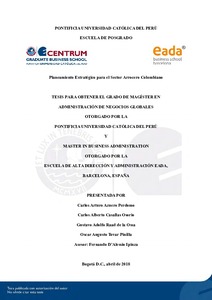| dc.contributor.advisor | D’Alessio Ipinza, Fernando Antonio | |
| dc.contributor.author | Azuero Perdomo, Carlos Arturo | es_ES |
| dc.contributor.author | Casallas Osorio, Carlos Alberto | es_ES |
| dc.contributor.author | Raad de la Ossa, Gustavo Adolfo | es_ES |
| dc.contributor.author | Tovar Pinilla, Oscar Augusto | es_ES |
| dc.date.accessioned | 2018-07-30T21:23:55Z | |
| dc.date.available | 2018-07-30T21:23:55Z | |
| dc.date.created | 2018 | |
| dc.date.issued | 2018-07-30 | |
| dc.identifier.uri | http://hdl.handle.net/20.500.12404/12357 | |
| dc.description.abstract | La producción de arroz en Colombia ha aumentado en los últimos años,
convirtiéndose en uno de los principales cultivos, no solo por su masificación sino por toda la
gente que involucra en sus procesos de producción, procesamiento y comercialización. En el
mercado internacional la participación del arroz colombiano es baja, a este respecto, se
plantea una inserción en este mercado explorando las bondades de los nuevos tratados
comerciales y los ajustes internos de proactividad alineados con los estándares de la OCDE.
Esta Planeación Estratégica analiza el sector externo identificando fortalezas,
oportunidades, debilidades y amenazas; además, define misión, visión, objetivos de largo y
corto plazo, estrategias y políticas correspondientes para fortalecer y mejorar el desarrollo del
Sector Arrocero Colombiano. Finalmente, se plantea la implementación, la evaluación y el
control estratégico con algunas conclusiones como que: (a) hay diferencias sustanciales de
costo beneficio, debido a las condiciones de transporte y acopio del producto; (b) el
rendimiento de la producción interna favorece el ingreso en los mercados internacionales de
fair trade, (c) la formación técnica es precaria, (d) la integración depende de los grandes
molinos y los comercializadores finales, creando un clima de inequidad, y (e) es baja la
existencia de créditos blandos.
Ante esto, se recomienda: (a) presentar esta planeación a Fedearroz y las instancias
gubernamentales competentes, (b) propendiendo por su liderazgo efectivo; (c) promoviendo
la integración vertical equitativa y (d) un plan de benchmarking basado en buenas prácticas
agrícolas mundiales; además de, (e) empoderar a Colciencias y a las instituciones
investigadoras, públicas y privadas, (f) continuar con el desarrollo de programas como
AMNTEC e Integración Hacia Adelante para que la renovación tecnológica de pequeños y
medianos agricultores, para (g) proyectar planes de mejora constante, en un clima de respeto
ambiental, socioeconómica y competitivo | es_ES |
| dc.description.abstract | The production of rice in Colombia has increased in recent years, becoming one of the
main crops, not only for its overcrowding but for all people involved in its production,
processing and marketing processes. In the international market, theres a low participation of
Colombian rice, an insertion in this market is being considered by exploring benefits of new
trade agreements and internal adjustments of proactivity aligned with OECD standards.
This Strategic Planning analyzes the external sector identifying strengths,
opportunities, weaknesses and threats; in addition, it defines mission, vision, long and short
term objectives, strategies and corresponding policies to strengthen and improve the
development of the Colombian Rice Sector. Finally, the implementation, evaluation and
strategic control are considered some conclusions such as: (a) there are substantial
differences in cost-benefit, due to the transport and storage conditions of the product; (b) the
performance of domestic production favors the entry into the fair trade international markets,
(c) the technical training is precarious, (d) the integration depends on the large mills and the
final traders, creating a climate of inequality, and (e) the existence of soft loans is low.
Given this, it is recommended: (a) present this planning to Fedearroz and the
competing governmental instances, (b) tend towards for its effective leadership; (c)
promoting equitable vertical integration; and (d) a benchmarking plan based on good global
agricultural practices; in addition to (e) empowering Colciencias and public and private
research institutions, (f) continue with the development of programs such as AMNTEC and
Integración Hacia Adelante for technological renovation of small and medium farmers, to (g)
project plans of constant improvement, in a climate of environmental, socioeconomic and
competitive respect | es_ES |
| dc.language.iso | spa | es_ES |
| dc.publisher | Pontificia Universidad Católica del Perú | es_ES |
| dc.rights | info:eu-repo/semantics/openAccess | es_ES |
| dc.rights.uri | http://creativecommons.org/licenses/by-nc-nd/2.5/pe/ | * |
| dc.subject | Arroz -- Industria y comercio -- Colombia | es_ES |
| dc.subject | Planificación estratégica | es_ES |
| dc.title | Planeamiento estratégico para el sector arrocero colombiano | es_ES |
| dc.type | info:eu-repo/semantics/masterThesis | es_ES |
| thesis.degree.name | Maestro en Administración de Negocios Globales | es_ES |
| thesis.degree.level | Maestría | es_ES |
| thesis.degree.grantor | Pontificia Universidad Católica del Perú. CENTRUM | es_ES |
| thesis.degree.discipline | Administración de Negocios Globales | es_ES |
| renati.advisor.dni | 41319855 | |
| renati.advisor.orcid | https://orcid.org/0000-0002-4242-1220 | es_ES |
| renati.discipline | 413307 | es_ES |
| renati.level | https://purl.org/pe-repo/renati/level#maestro | es_ES |
| renati.type | https://purl.org/pe-repo/renati/type#tesis | es_ES |
| dc.publisher.country | PE | es_ES |
| dc.subject.ocde | https://purl.org/pe-repo/ocde/ford#5.02.04 | es_ES |






